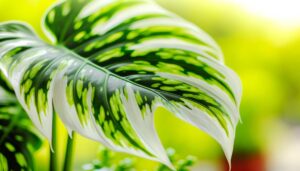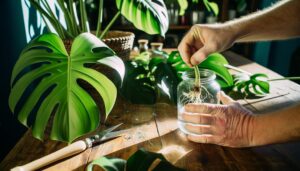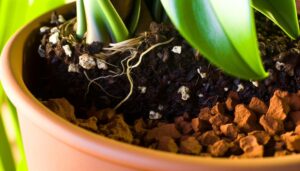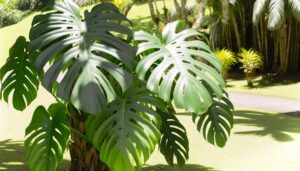Can Monstera Adansonii Grow in Water? Comprehensive Guide!
Yes, Monstera Adansonii can thrive in water through a thorough propagation process. Start by submerging the node in dechlorinated water, making sure leaves remain above the surface.
Changing water weekly is vital to maintain oxygen levels and prevent bacterial growth. Monitoring pH and using clear containers enhances root health visibility and nutrient uptake.
To promote best growth, ensure water temperature is between 65-75°F and supplement light with full-spectrum LEDs. Regularly check for pests and root rot, using sterile water to minimize issues.
For deeper insights into each step and nutrient management strategies, looking further can provide in-depth understanding.
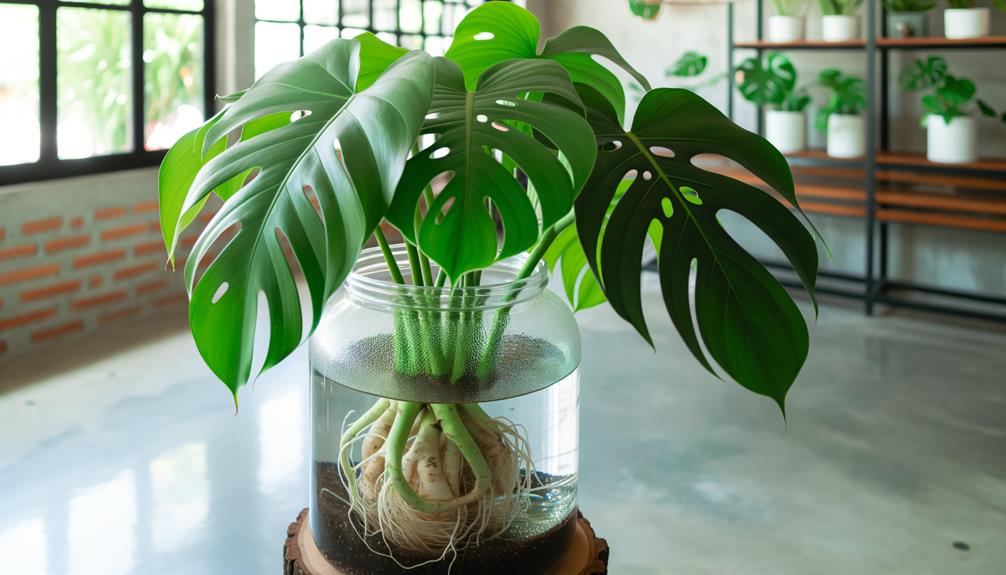
Key Takeaways
- Yes, Monstera Adansonii can grow in water using water propagation techniques.
- Ensure the cutting’s node is submerged while leaves remain above water.
- Change water weekly to maintain oxygen levels and prevent bacteria.
- Use transparent, non-reactive containers to monitor root health.
- Provide 12-14 hours of light daily with full-spectrum LEDs for optimal growth.
Understanding Water Propagation
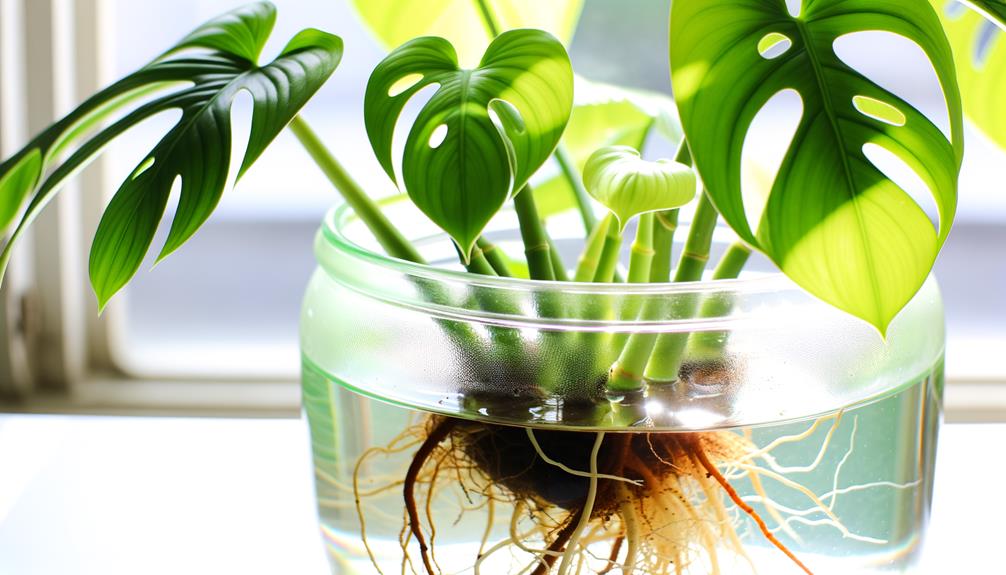
Water propagation is a technique that leverages the natural rooting ability of Monstera Adansonii cuttings. It is both an efficient and fascinating method for plant enthusiasts. To propagate, you’ll need a healthy stem cutting with at least one node, where roots will develop.
Submerge the node in water, making sure leaves remain above the surface to prevent rot. Change the water weekly to maintain oxygen levels and prevent bacterial growth. Within weeks, you’ll observe root emergence.
Confirm the water is at room temperature and avoid direct sunlight to mitigate algae formation. This method not only allows you to monitor root development easily but also simplifies transferring the cutting to soil when roots are robust enough.
Proper water propagation fosters healthy, vigorous Monstera Adansonii plants.
Benefits of Growing in Water
Growing Monstera Adansonii in water offers numerous advantages, including enhanced root visibility and simplified nutrient management. You’ll appreciate observing root development, allowing for early detection of root rot or deficiencies.
In a hydroponic setup, nutrient solutions can be precisely controlled, ensuring ideal growth conditions. This method also minimizes the risk of soil-borne pathogens, promoting healthier plant development.
Water propagation reduces the frequency of watering and soil aeration issues, providing a more stable environment for your Monstera. Additionally, it’s easier to monitor and adjust pH levels, essential for nutrient uptake.
Choosing the Right Container

Selecting the best container is essential for the successful hydroponic cultivation of Monstera Adansonii, as it directly influences root health and nutrient accessibility. You should opt for a see-through container to monitor root development and detect any early signs of root rot. The container should be roomy enough to accommodate the expanding root system without constraint. Additionally, make sure it’s made from non-reactive materials to prevent chemical leaching into the water.
| Container Attribute | Importance |
|---|---|
| Transparency | Monitors root health and growth |
| Size | Prevents root crowding |
| Material | Avoids chemical leaching |
| Stability | Guarantees plant remains upright |
Choosing the right container sets the foundation for a thriving hydroponic environment, promoting top-notch growth and nutrient uptake for your Monstera Adansonii.
Preparing Your Plant
To maximize the growth of your Monstera adansonii, start by selecting healthy cuttings with at least one node and several leaves.
Place the cuttings in water treated to remove chlorine and balance pH levels.
Regularly monitor the water’s temperature, keeping it between 65-75°F for best root development.
Selecting Healthy Cuttings
For best outcomes, make certain you choose cuttings with at least two nodes and healthy, vibrant leaves. Inspect the stem for any signs of disease or damage. Nodes are critical as they contain meristematic tissue necessary for root development. Use sterilized scissors or pruning shears to make clean cuts.
| Criteria | Ideal Characteristics | Emotional Impact |
|---|---|---|
| Nodes | At least two per cutting | Hopeful |
| Leaves | Bright green, no blemishes | Joyful |
| Stem Condition | Firm, no rot or dark spots | Confident |
| Cutting Length | 4-6 inches | Excited |
| Tools Used | Sterilized scissors/shears | Reassured |
Selecting robust cuttings ensures a higher success rate for root development, giving you the confidence to propagate Monstera Adansonii in water.
Proper Water Conditions
Maintaining ideal water conditions involves keeping a clean environment, using dechlorinated or distilled water, and monitoring temperature and pH levels.
Start by thoroughly cleaning your container to remove any contaminants. For water, choose dechlorinated or distilled varieties to prevent chemical interference with root development. Tap water often contains chlorine and chloramines that can be harmful to plant health.
Maintain the water temperature between 65-75°F (18-24°C) to replicate natural tropical conditions. Regularly monitor the pH level, aiming for a range of 5.5 to 7.0, as Monstera Adansonii thrives in slightly acidic to neutral water. Use a pH meter for accuracy.
Change the water every 1-2 weeks to prevent bacterial buildup and maintain ideal growth conditions.
Water Quality Matters
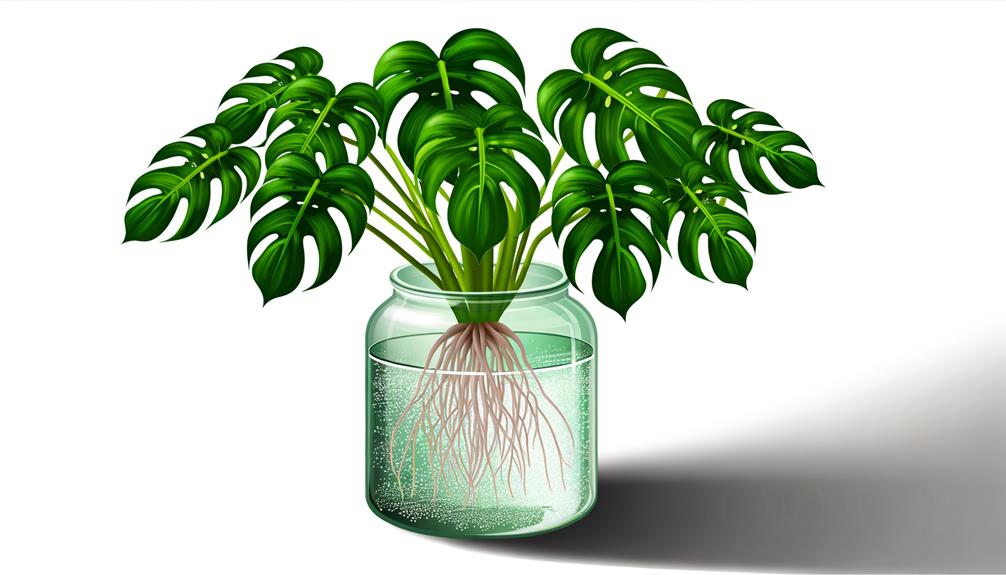
When growing Monstera Adansonii in water, you’ll need to prioritize water quality to guarantee plant health.
Guarantee the water’s cleanliness and purity to prevent harmful bacterial growth.
Additionally, monitor the pH level and mineral content to maintain a balanced nutrient profile for the plant.
Cleanliness and Purity
Maintaining ideal water quality is vital for the health and growth of Monstera Adansonii, as impurities can lead to root rot and stunted development.
You should use distilled or filtered water to avoid contaminants such as chlorine, heavy metals, and pathogens.
Regularly change the water, ideally every 1-2 weeks, to prevent the accumulation of algae and bacterial growth.
Clean the container thoroughly to remove biofilm and residue, which can harbor harmful microorganisms.
Employing an aeration system can enhance oxygen levels, promoting healthier root systems.
Monitoring the water’s temperature is also important; aim for a consistent range between 65-75°F (18-24°C).
Ph Level Importance
Monitoring the pH level of your water is crucial because Monstera Adansonii roots can only absorb nutrients effectively within a specific pH range. Ideally, aim for a pH between 5.5 and 7.5. Deviating from this range can lead to nutrient lockout, impacting your plant’s health. Regularly testing the water ensures prime conditions for root function.
| pH Level | Effect on Monstera Adansonii |
|---|---|
| Below 5.5 | Nutrient lockout, acidic stress |
| 5.5 – 7.5 | Optimal nutrient uptake |
| Above 7.5 | Alkaline stress, nutrient deficiencies |
| Variable | Inconsistent growth, poor health |
Using a digital pH meter or pH test strips, you can maintain the ideal pH. Adjusting water pH with natural additives like lemon juice (acidic) or baking soda (alkaline) helps keep your Monstera thriving.
Minerals and Nutrients
Optimizing your Monstera Adansonii to access necessary minerals and nutrients is essential for its growth and overall health.
When growing in water, you need to supplement with a balanced hydroponic fertilizer. This solution should contain essential macronutrients like nitrogen (N), phosphorus (P), and potassium (K), as well as micronutrients such as magnesium, calcium, and iron.
Regularly monitor the water’s electrical conductivity (EC) to ensure nutrient concentration remains at its best.
Dechlorinated or distilled water is preferable, as tap water often contains chlorine and fluoride, which can harm the plant.
Additionally, changing the water every two weeks prevents nutrient imbalances and microbial growth.
Lighting Requirements
Adequate lighting is necessary for the healthy growth of Monstera Adansonii when cultivated in water. You should provide bright, indirect light to mimic its natural tropical habitat. Direct sunlight can cause leaf burn, a condition where the foliage becomes scorched and turns brown. Position your plant near a north or east-facing window, or use sheer curtains to diffuse sunlight.
Photoperiodicity, the plant’s response to the length of day and night, plays an important role; aim for 12-14 hours of light daily. In low-light conditions, the plant’s photosynthetic efficiency diminishes, resulting in leggy growth and poor foliage development. Supplemental grow lights, particularly full-spectrum LEDs, can be beneficial if natural light is insufficient.
Nutrient Needs
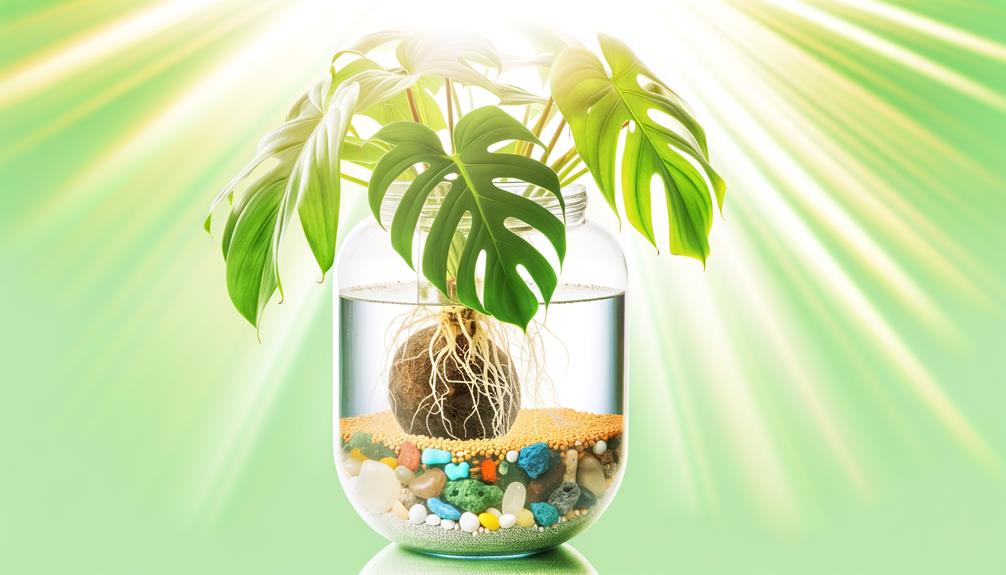
To keep your Monstera Adansonii thriving in water, you must address its essential nutrient requirements.
In hydroponic systems, the plant relies on a balanced hydroponic fertilizer to supply necessary macro and micronutrients.
Use a fertilizer specifically designed for hydroponic applications to maintain peak growth and health.
Essential Nutrient Requirements
Proper nutrient balance is important for Monstera Adansonii growing in water to maintain peak health and vibrant growth. You’ll need to guarantee an adequate supply of macronutrients like nitrogen (N), phosphorus (P), and potassium (K). Nitrogen promotes lush, green foliage, phosphorus supports root development, and potassium enhances overall plant health.
Micronutrients, including iron (Fe), manganese (Mn), and zinc (Zn), though required in smaller amounts, are equally essential. Iron is crucial for chlorophyll synthesis, manganese plays a role in photosynthesis, and zinc aids in enzyme function.
Regularly monitor water pH, aiming for a range of 5.5 to 6.5, to optimize nutrient uptake. Remember, nutrient deficiencies or imbalances can manifest as stunted growth, chlorosis, and poor root development.
Hydroponic Fertilizer Options
For best growth of Monstera Adansonii in water, selecting a hydroponic fertilizer that provides a balanced mix of essential macronutrients and micronutrients is important. You’ll need a formula containing nitrogen (N), phosphorus (P), and potassium (K) in appropriate ratios, typically around 2-1-6 for leafy growth.
Micronutrients like iron (Fe), magnesium (Mg), and calcium (Ca) are essential for preventing deficiencies and promoting overall health. Use a hydroponic-specific fertilizer to guarantee solubility and bioavailability in a water-based environment.
Monitor the electrical conductivity (EC) and pH levels to maintain nutrient uptake efficiency. Adjust your nutrient solution every two weeks to sustain optimal conditions and encourage robust growth in your Monstera Adansonii.
Monitoring Root Development
Regularly check the Monstera adansonii’s roots for signs of healthy growth, like pale coloration and sturdy texture, to enhance development in water. Examine for root elongation and branching, which indicate nutrient absorption and overall plant health. Utilize a see-through container to track progress without disturbing the plant.
Roots should be submerged but not overcrowded, guaranteeing ideal oxygen levels and preventing oxygen deficiency. Replace the water weekly to sustain nutrient balance and avoid stagnation. If you observe any brown or mushy roots, trim them promptly to prevent rot from spreading.
Monitoring root development assists in adjusting environmental conditions, such as light and nutrient levels, promoting vigorous growth. Consistent observation ensures your Monstera adansonii flourishes in a hydroponic system.
Managing Pests and Diseases
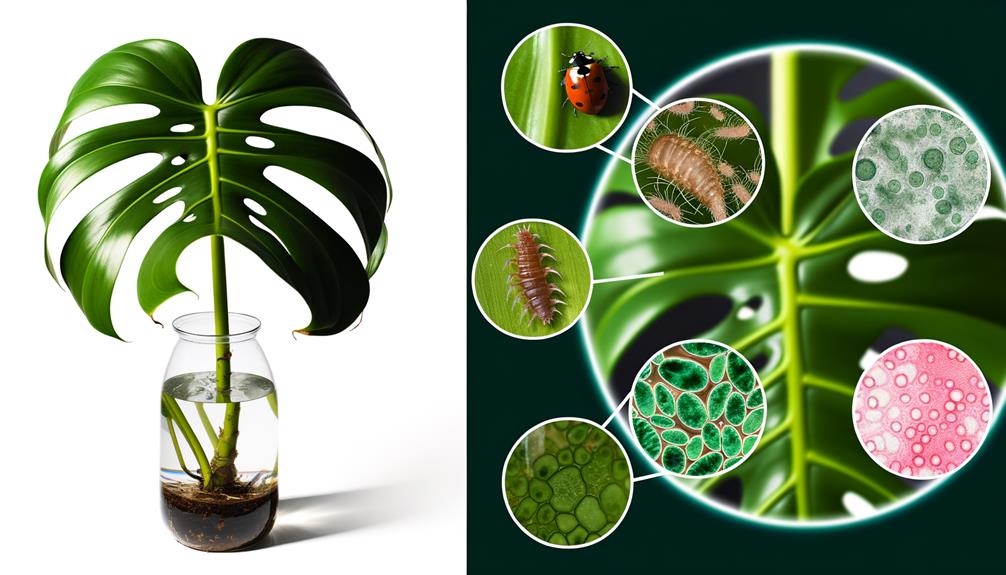
While cultivating your Monstera adansonii in water, promptly identify and manage pests and diseases to maintain plant health and essentiality.
Examine leaves and stems regularly for signs of spider mites, aphids, or scale insects. Use a magnifying glass for thorough inspection. If pests are present, treat the plant with insecticidal soap or neem oil, guaranteeing complete coverage.
Diseases like root rot can still occur in water culture; monitor roots for any brown, mushy segments. Remove affected parts and refresh the water frequently to prevent pathogen buildup.
Sustain peak water quality by using distilled or filtered water and changing it every couple of weeks. These proactive measures will help optimize your Monstera adansonii’s flourishing in its aquatic habitat.
Common Challenges
Cultivating Monstera adansonii in water presents several challenges including nutrient deficiencies, algae growth, and root oxygenation issues. These issues can severely impact the health of your plant.
- Nutrient Deficiencies: Water lacks essential minerals found in soil, which can hinder growth.
- Algae Growth: Light exposure can promote algae, competing with the plant for oxygen and nutrients.
- Root Oxygenation: Stagnant water reduces oxygen availability, leading to root rot and decay.
- Water Quality: Tap water often contains chlorine and other chemicals detrimental to plant health.
Addressing these challenges requires a precise approach, such as using hydroponic nutrients, maintaining clean water, and ensuring adequate oxygenation through aeration systems. Understanding these complexities will enhance your ability to successfully grow Monstera adansonii in water.
Transitioning to Soil
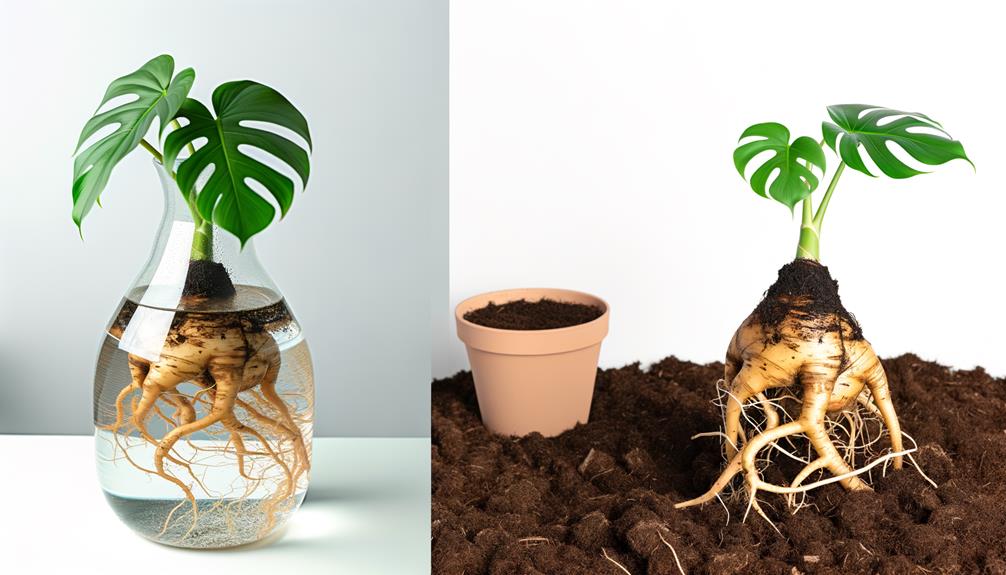
Moving your Monstera adansonii from water to soil involves careful acclimatization to guarantee the plant adapts to its new growing medium without stress. Begin by preparing a well-draining potting mix, ideally a mix of peat moss, perlite, and orchid bark.
Carefully remove the plant from the water, gently rinsing the roots to clear any debris. Inspect the roots for rot or damage and trim as necessary. Gradually introduce the plant to soil by initially placing it in moist substrate, maintaining high humidity to mimic its aquatic conditions.
Over the next week, reduce watering frequency to encourage root adaptation. Monitor for signs of stress, such as wilting or yellowing leaves, and adjust care practices accordingly to guarantee a successful shift.
Success Stories
Successfully acclimating your Monstera adansonii to soil opens the door to numerous inspiring success stories from plant enthusiasts who’ve mastered this process. These stories highlight the resilience and adaptability of the species, and they often share key insights that can guide your journey.
- Root Development: Many have observed robust root structures after shifting from water to soil, enhancing nutrient uptake.
- Leaf Growth: Reports show significant increases in leaf size and fenestration, indicating peak health.
- Pest Resistance: Healthy, soil-grown Monstera adansonii are often more resistant to common pests like spider mites.
- Long-Term Viability: Consistent soil cultivation has led to plants thriving for years, showcasing the plant’s durability.
Conclusion
Exploring the subtleties of Monstera adansonii water propagation can seem challenging, but with diligence and proper care, your plant will thrive.
Remember, water quality is crucial—like a lifeline to your plant. Choose a transparent container to monitor root development, and be vigilant against pests.
Shifting to soil might be necessary as the plant matures, ensuring robust growth. Armed with this knowledge, you’re ready to cultivate a lush, water-grown Monstera adansonii.
Happy growing!

